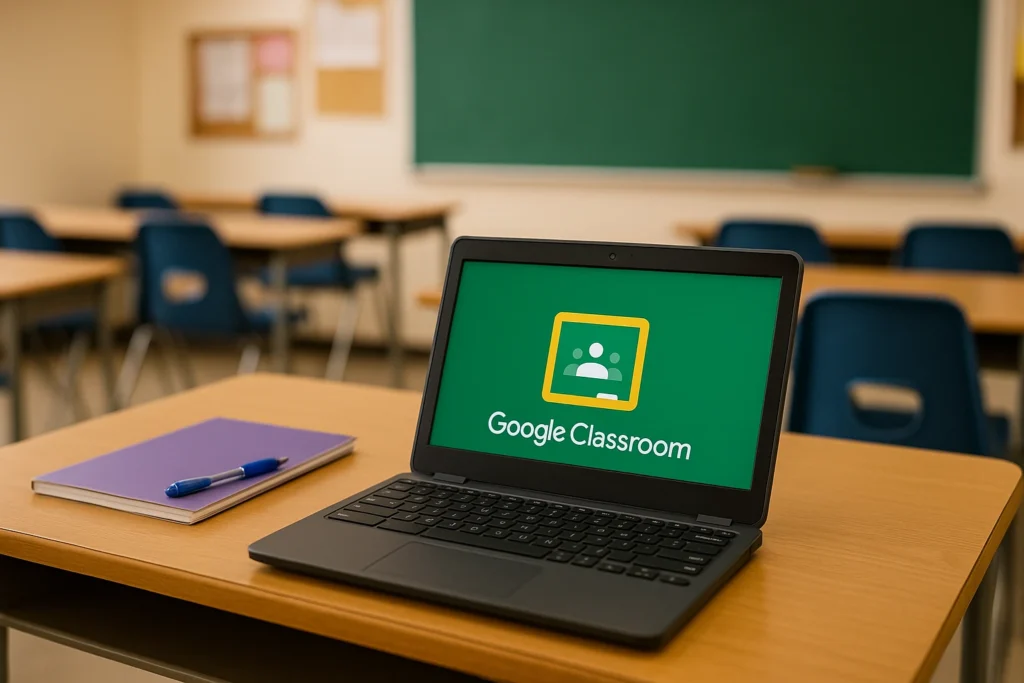Three different schools, three different learning management systems, and you still haven’t figured out how to make technology work for you instead of against you.
Every teacher knows this struggle well. Too many apps to manage, WiFi that doesn’t work, and making your own materials because you can’t find what you need.
The workload keeps growing while your energy keeps shrinking.
In this guide, we’ll show you the essential teacher tech tools in 2025 that actually solve real classroom problems, so you can focus on teaching instead of troubleshooting digital chaos.
We’ll cover:
- Tools that save hours every week
- Google Classroom setup in 5 minutes
- Free content that actually works
- Apps that engage any class instantly
- Making tech work in any school
We’ve helped hundreds of teachers across London master their digital toolkit using these proven strategies. These educators now report smoother lessons and better work-life balance.
It’s time to discover how the right technology changes your teaching experience.
Why Digital Learning Transforms Your Teaching Day
Transforming education sounds grand, but let’s be honest. You just want to get through your day without the usual chaos. Most educators juggle too many apps and spend evenings creating resources from scratch. Sometimes they end up feeling like the workload never stops growing.
Have you thought about going smart? Let me explain what changes when you choose smart digital learning tools:
Reclaim Your Evenings
Stop wasting your weekends planning lessons and marking assignments (teachers deserve to rest, too). The right technology handles these routine tasks automatically, which gives teachers back precious time for actual instruction and rest.
Well, how does this work in practice? Okay, let me explain this to the point. Automated grading systems process quiz results in seconds, not hours of red pen marking.
Meanwhile, digital lesson plans adapt to any subject with minimal tweaking, so you’re not starting from scratch every time. Teachers, including myself, have tried this setup, and we ended up gaining 5-7 hours weekly time to ourselves.
Connect With Every Student
Teachers usually have one quiet child in class that they struggle to deal with. Well, no more struggling! Video response tools give the quiet ones a voice they’re comfortable using. On the flip side, the restless ones suddenly focus for entire lessons when interactive AI platforms grab their attention.
These aren’t isolated success stories either. Digital approaches reach visual learners through videos, auditory learners through recordings, and hands-on learners through interactive content. All within the same lesson.
The result is simple: students engage differently when learning becomes interactive rather than passive listening.
Walk Into Any Classroom Ready
Picture walking into your fourth different school this month. You are having to adjust to everything from scratch again. This scenario can be terrifying, but not when you have your personal tech toolkit ready to go.
Your familiar digital tools work regardless of the school’s setup. While other teachers scramble to understand new platforms, you simply open your trusted apps and start teaching. Supply teachers tell us this confidence boost transforms their entire approach to new classroom environments.
But which specific tools actually deliver on these promises? Google Classroom handles the backbone of digital classroom management, so let’s explore how it works in practice.
Google Classroom: Your Portable Teaching Hub

Google Classroom is the universal solution for teachers for managing digital chaos without losing their minds. Most classroom management platforms promise everything but deliver confusion. Don’t worry, this works. The difference becomes obvious once you start using it regularly.
Key Benefits:
- 5-minute setup process for any subject (seriously, that’s all it takes)
- Works offline when school WiFi inevitably crashes, syncing later automatically
- Automatically sorts student submissions so you’re not hunting through emails
- Plays nicely with existing school systems instead of fighting them
The real magic takes place when you realise the efficiency this brings to your teaching routine. Simply create lesson plans once, duplicate them for different classes, and watch students turn work in on time.
No more chasing down missing assignments or dealing with “the printer wasn’t working” excuses.
For supply teachers, Google Classroom becomes your portable office. Walk into any school with everything you need stored safely in the cloud. Your lessons, resources, and student communication all live in one simple interface. This approach makes digital classroom management foolproof.
Khan Academy: Ready-Made Brilliant Lessons

On any occasion, have you been assigned to teach a subject you haven’t thought about since university? Always gave me big scares until Khan Academy happened.
Last month, a supply teacher, in the same shoes as me, walked into a Year 8 science lesson about photosynthesis with zero preparation. The regular teacher had left vague notes, and 30 restless students were already asking questions she couldn’t answer.
Within minutes of opening Khan Academy, she found interactive diagrams, clear explanations, and practice exercises that helped her dive into teaching the class instantly. The lesson shifted from a potential disaster to a genuine learning success.
Khan Academy covers 95% of the UK curriculum topics with content created by actual experts. But, how does this help you? Well, students get learning that adapts to their pace automatically. Meanwhile, you access ready-made resources for any subject without the usual prep work.
The content works for different ability levels, too! So, differentiation becomes simple instead of stressful.
Covering fractions for Year 3? Khan Academy has you sorted. Teaching Shakespeare for GCSE? Same story. Quality lessons wait at your fingertips, removing the fear of unfamiliar topics.
Expert-created content supports you every time you enter unfamiliar teaching territory. But having great content is just the first step. Next comes making sure students successfully engage with it.
Four Apps That Save Difficult Lessons
Every teacher knows that moment when Plan A fails and you need a Plan B. Technology can either save the day or make things worse.
So how do you ensure it helps instead of hurts? Smart teachers keep these four apps ready for exactly these moments. Each one transforms difficult classes into engaged learners:
1. Kahoot: Quiz Magic That Works Every Time
Creates instant competition that even backbenchers want to join. The beauty lies in its simplicity. The three-minute setup delivers guaranteed participation from your most challenging class. You simply create questions, students use their phones to answer, and the leaderboard updates in real time.
The competitive element works because students see their ranking change with every correct answer. Even the quietest learners get drawn into the excitement when they climb the scoreboard. With this approach, revision sessions are no longer dull and quiet.
2. Padlet: Collaboration Made Easy
Moving beyond individual competition, this digital wall lets every student contribute ideas simultaneously. Also, eliminates awkward silence during discussions.
Perfect for brainstorming sessions that work.
3. ClassDojo: Instant Classroom Calm
When collaboration isn’t enough and you need behaviour management, this point system provides immediate feedback that students actively respond to. Best of all, visual tracking calms disruptive classes within minutes.
4. Flipgrid: Video Confidence Builder
Many students struggle with verbal participation. This video’s responses offer a private way for quiet learners to find their voice. Because it’s recorded privately, communication skills improve without the fear of speaking publicly.
Such AI tools solve classroom problems without creating new headaches. The features work intuitively, so students focus on learning instead of figuring out technology. When standard teaching methods hit a wall, these tools provide the breakthrough you need.
Making Teaching Tech Tools Work Everywhere

Every school has different rules about technology, but smart teachers adapt rather than surrender.
Some schools block social media platforms, others restrict downloads, and a few still operate with outdated systems that make modern teaching feel impossible. What works is preparing for these limitations ahead of time.
My suggestion is to use these strategies to make any tool work in any environment:
Smart Workarounds:
- Download offline versions before arriving at new schools
- Use mobile data as backup when WiFi fails completely
- Master 3 tools really well rather than 10 poorly
- Always prepare non-tech alternatives for complete failures
- Check school policies during your first break, not mid-lesson
- Save login details in your phone’s password manager for quick access
Technology should adapt to your teaching style, not dictate it. When schools limit access to certain AI platforms, your backup plans keep lessons running smoothly.
Supply teachers, in particular, benefit from this flexible approach, as every school environment presents different challenges and opportunities.
We have convinced you that these tools matter. But where do you start implementing them?
Getting Started With Your Teaching Tech Toolkit
The best teaching toolkit in the world won’t help if it stays on this page. Action beats perfection every time; you must have heard it. So, it’s true that your digital confidence grows through practice, not endless planning.
Start with Google Classroom this week by setting up one simple class. Next week, explore Khan Academy for your toughest subject. By week three, try one engagement app during difficult lessons. This approach prevents overwhelm while building real skills.
At OTJR Online, we understand how supply teachers handle different school environments. Our team provides ongoing support to help you build confidence with digital tools and teaching placements.
Contact us today to learn how our London teaching opportunities can help you practice these skills in supportive school communities.

